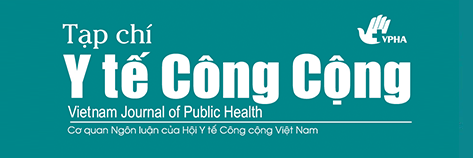Một sức khỏe: Quan niệm và triển vọng cho y tế công cộng (One Health: concept and perspectives for public health)
Tóm tắt
Một sức khỏe (One Health) gần đây được thảo luận nhiều ở các diễn đàn khoa học quốc tế và khu vực và thu hút được sự quan tâm. Đây là một hướng phát triển và ứng dụng quan trọng trong thời gian tới trong việc chăm sóc sức khỏe con người dựa vào sự phối hợp và hiểu biết mối quan hệ chặt chẽ giữa sức khỏe con người, sức khỏe động vật và môi trường. Bài báo sẽ giới thiệu những điểm cơ bản của khái niệm Một sức khỏe gắn liền với lịch sử phát triển của nó. Bài báo cũng thảo luận một số hoạt động liên quan đến Một sức khỏe ở Việt Nam đã và đang được triển khai trong lĩnh vực quản lí và can thiệp các bệnh mới nổi cũng như các chương trình đào tạo liên quan. Cuối cùng, chúng tôi sẽ thảo luận những thách thức ở phía trước của viêc ứng dụng một sức khỏe trong lĩnh vực đào tạo và nghiên cứu liên quan đến y tế công cộng và nhấn mạnh sự quan trọng của tính xuyên ngành trong áp dụng cách tiếp cận này.
English abstract
One Health has recently been discussed at many regional and international conferences and attracted attention and investment of different stakeholders. This is an important development and application in improving health through the understanding of the close links among human, animal and environmental health. This paper introduces the main concept of One Health and the history of its development. We discuss past and ongoing activities related to One Health in management and interventions for emerging infectious and zoonotic diseases, as well as the training programs in Vietnam. Finally, we present challenges ahead when applying One Health in training and research in public health and emphasize the importance of transdisciplinarity for One Health application.
Từ khóa
Toàn văn:
PDF (English)##submission.citations##
Schelling, E., Wyss, K., Bechir, M., Moto, D. & Zinsstag, J. (2005), "Synergy between public health and veterinary services to deliver human and animal health interventions in rural low income settings", BMJ, 331(1468-5833 (Electronic)), pp. 1264-1267.
Zinsstag, J., Schelling, E., Roth, F., Bonfoh, B., de Savigny, D. & Tanner, M. (2007), "Human benefits of animal interventions for zoonosis control", Emerging Infectious Diseases, 13(1080-6040 (Print)), pp. 527-531.
Anonymous (2011), "1st Internstional One Health Congress Summary 14-16 February 2011. Accessed on 14/9/2011: www.onehealth2011.com".
Anonymous (2011), "The Vietnam integrated national operational program on avian influenza, pandemic preparedness and other emerging infectious diseases (AIPED), 2011-2015: Strengthening responses and improving prevention through a One Health approach".
Charron, D. (In press) Ecohealth: origins and approach. IN Charron, D. (Ed.) Ecohealth research in practice: Innovative applications of an ecosystem approach to health. Springer, Ottawa.
Coker, R. J., Hunter, B. M., Rudge, J. W., Liverani, M. & Hanvoravongchai, P. (2011), "Emerging infectious diseases in southeast Asia: regional challenges to control", Lancet, 377(9765), pp. 599 - 609.
DAH/MARD & GDPM/MOH (2011), "Workshop on prioritization and mapping of activities on zoonotic diseases in Vietnam, Hanoi, 11-12 August 2011".
Daszak, P., Cunningham, A. A. & Hyatt, A. D. (2000), "Emerging Infectious Diseases of Wildlife- Threats to Biodiversity and Human Health", Science, 287pp. 443-449.
FAO, OIE, WHO, UNSIC, UNICEF & WB (2008), "Contributing to One World, One Health: A Strategic Framework for Reducing Risks of Infectious Diseases at the Animal–Human–Ecosystems Interface".
Frenk, J., Chen, L., Bhutta, Z. A., Cohen, J., Crisp, N., Evans, T., Fineberg, H., Garcia, P., Ke, Y., Kelley, P., Kistnasamy, B., Meleis, A., Naylor, D., Pablos-Mendez, A., Reddy, S., Scrimshaw, S., Sepulveda, J., Serwadda, D. & Zurayk, H. (2010), "Health professionals for a new century: transforming education to strengthen health systems in an interdependent world", The Lancet, 376(9756), pp. 1923-1958.
Jones, K., Patel, N., Levy, M., Storeygard, A. & Balk, D. (2008), "Global trends in emerging infectious diseases", Nature, 451pp. 990-993.
Kahn, L. H. (2006), "Confronting zoonoses, linking human and veterinary medicine", Emerging Infectious Diseases, 12pp. 556-561.
Robertson, J. (2003), "The Economic Costs of Infectious Diseases. Research Note no. 36. 2002-03, Parliament of Australia".
Saunders, L. Z. (2000), "Virchow’s contributions to veterinary medicine:celebrated then forgotten now.", Vet.Pathol, 37pp. 199–207.
Schwabe, C. (1964, 1984 3rd Edition), Veterinary Medicine and Human Health, Williams and Wilkins, Baltimore.
Taylor, L., Latham, S. & Woolhouse, M. (2001), "Risk factors for human disease emergence", Philosophical Transactions of the Royal Society of London Series B Biological Sciences, 356pp. 983-989.
Tuyet-Hanh, T. T., Vu-Anh, L., Ngoc-Bich, N. & Tenkate, T. (2010), "Environmental Health Risk Assessment of Dioxin Exposure through Foods in a Dioxin Hot Spot—Bien Hoa City, Vietnam", International Journal of Environmental Research and Public Health, 7pp. 2395-2406.
USAID (2011), "http://www.usaid.gov/our_work/global_health/home/News/ai_docs/emerging_threats.pdf)".
WHO (2003), "Viet Nam SARS-Free. Accessed on 14/9/2011: http://www.who.int/mediacentre/news/releases/2003/pr_sars/en/".
WHO (2010), Asia Pacific strategy for emerging diseases, World Health Organization, Western Pacific Region, South-East Asia Region, Manila.
Wilcox, B. & Colwell, R. (2005), "Emerging and Reemerging Infectious Diseases: Biocomplexity as an Interdisciplinary Paradigm", EcoHealth, 2(4), pp. 244-257.
Zinsstag, J. (2007), "Animal health research", Science, 315pp. 1193.
Zinsstag, J., Schelling, E., Waltner-Toews, D. & Tanner, M. (2011), "From "one medicine" to "one health" and systemic approaches to health and well-being", Preventive Veterinary Medicine, 101(3-4), pp. 148-56.



